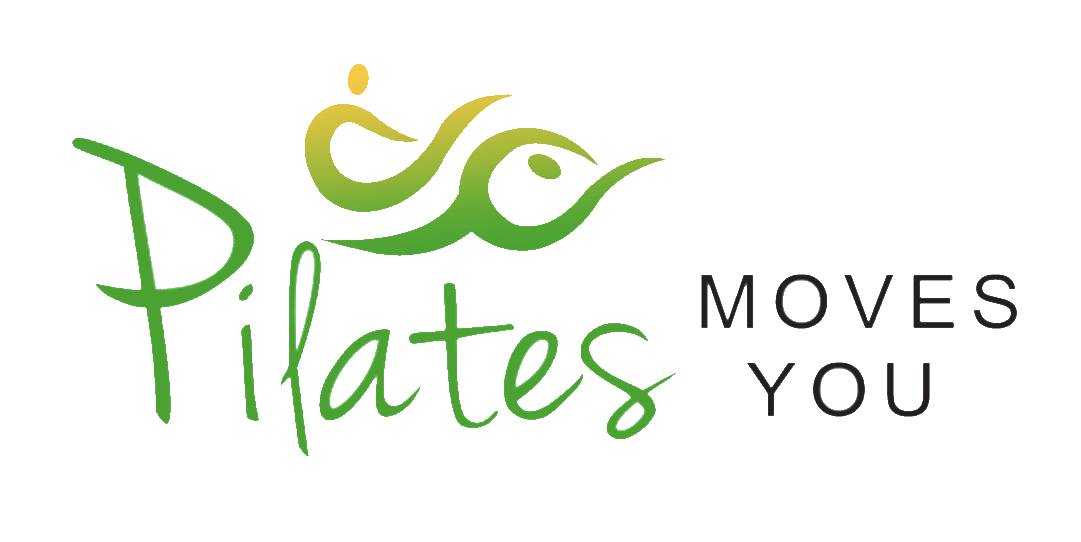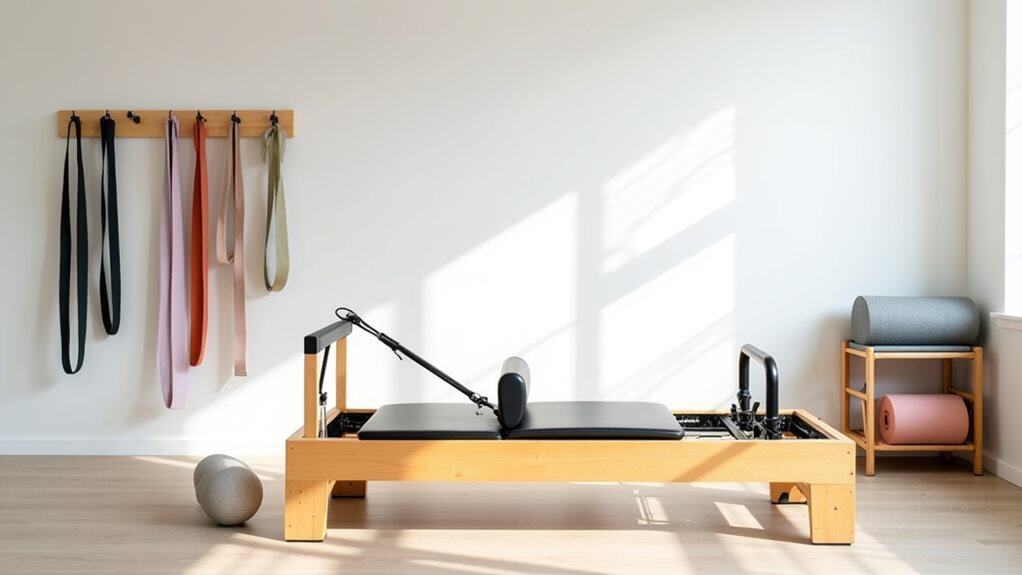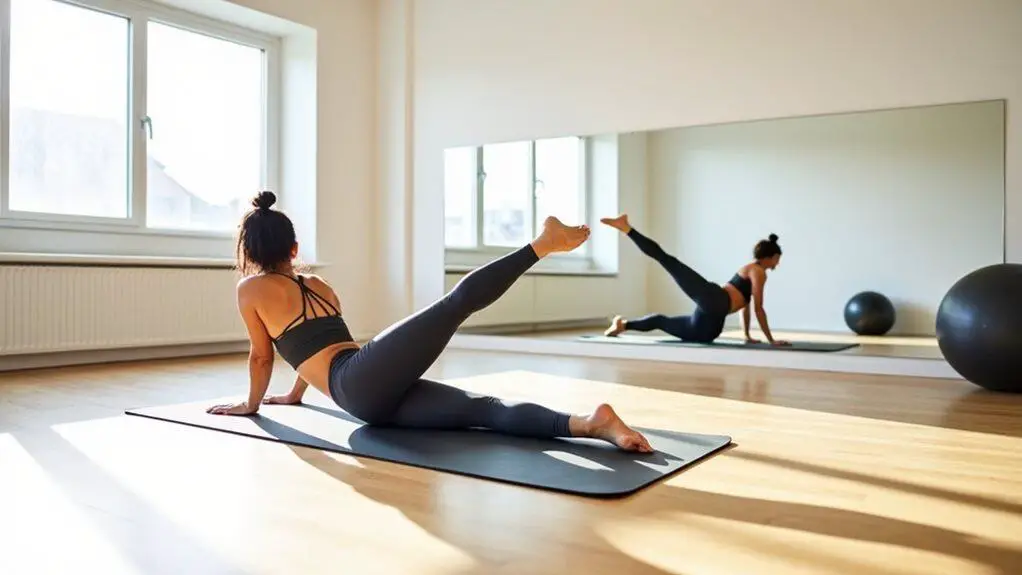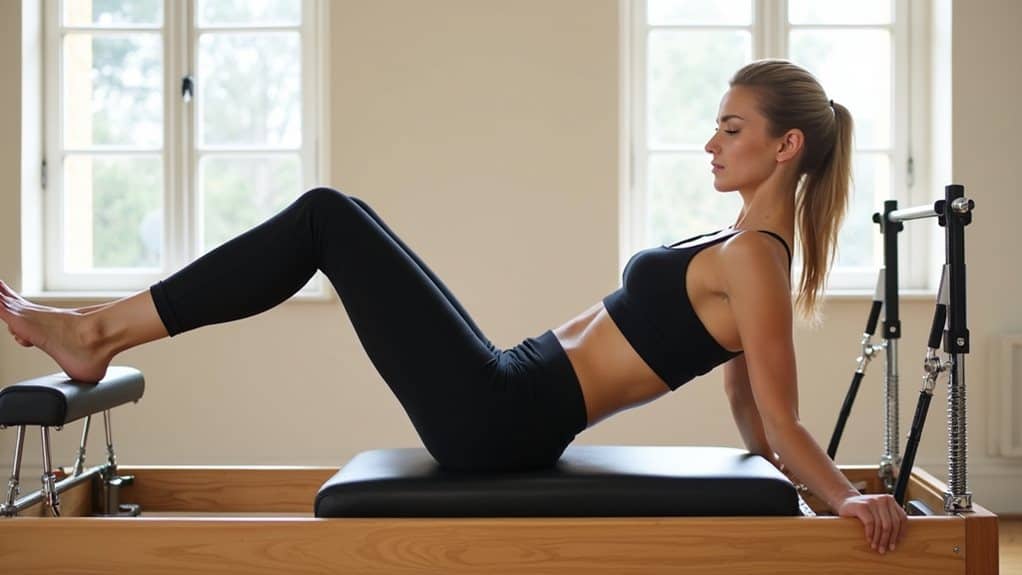Start your home Pilates studio with a high-quality mat (6-10mm thick) and essential props like resistance bands and small hand weights. You’ll need foam rollers for myofascial release, magic circles for inner thigh work, and stability balls for core control. For advanced practice, consider a reformer system with adjustable springs and integrated tower attachments. Proper equipment selection and maintenance will guarantee peak performance as you progress. Understanding the complete setup requirements will transform your practice to studio-level quality.
The Foundation: Your Pilates Mat and Props
A proper foundation begins with essential Pilates equipment for your home practice.
You’ll need a high-quality mat with adequate thickness to protect your spine and joints during floor exercises. Choose a mat between 6-10mm thick for ideal support and stability during your routines.
To enhance your practice, you’ll want to incorporate prop variety.
Essential props include resistance bands for muscle engagement, foam rollers for myofascial release, and small hand weights for added resistance.
Magic circles target inner thigh and arm strength, while stability balls challenge your core control.
Small props like yoga blocks and bolsters assist with alignment and modifications.
These tools allow you to progress systematically through different exercise levels while maintaining proper form and achieving maximum benefits from your home Pilates sessions.
Small Equipment Essentials for Targeted Training
Beyond the basic mat and props, targeted Pilates training requires specific small equipment pieces to maximize your results.
To enhance your practice and achieve precise muscle engagement, you’ll need several essential tools that provide progressive resistance and stability challenges.
- High-quality resistance bands in varying tensions allow you to modify exercises and create customized resistance levels for upper and lower body workouts.
- Balance balls help develop core stability while improving posture and coordination during dynamic movements.
- Small weighted balls (2-3 lbs) intensify exercises and add resistance to traditional mat sequences.
- Magic circles target inner thigh muscles and provide feedback for proper form during bridge work and standing exercises.
Choose equipment that suits your current fitness level and allows for progression as your strength improves.
Understanding the Pilates Reformer
The Pilates reformer combines essential components – a carriage, springs, straps, and footbar – to create a versatile resistance-based exercise platform.
You’ll need to master proper spring tension, carriage position, and strap length adjustments to guarantee safe, effective workouts tailored to your fitness level.
Reformer training enhances core strength, flexibility, and muscle control through controlled movements against variable resistance, making it a cornerstone of extensive Pilates practice.
Key Parts and Mechanics
Understanding how a Pilates reformer works starts with its essential components. The Pilates mechanics rely on a sophisticated system of springs, pulleys, and a sliding carriage that creates resistance for your workout. You’ll find these fundamental equipment types working together to deliver a full-body exercise experience.
- The carriage glides smoothly on wheels along parallel tracks, responding to your body’s movements and the spring tension.
- Multiple resistance springs attach to the footbar, allowing you to adjust the workout intensity based on your strength level.
- A sturdy frame supports the entire mechanism, typically constructed from wood or metal for maximum stability.
- The adjustable footbar and shoulder blocks enable proper body positioning and alignment during different exercises, ensuring correct form throughout your routine.
Adjusting Your Reformer Setup
Proper setup of your Pilates reformer directly impacts workout effectiveness and safety.
Begin by checking the carriage’s smooth movement and spring tension settings before each session. Adjust the headrest angle to maintain proper cervical spine alignment during supine exercises. Position the shoulder blocks to match your body dimensions and exercise requirements.
Key reformer adjustments include setting the footbar height appropriate to your leg length and exercise type. Verify the straps are even in length and properly threaded through the pulleys.
For safety and peak performance, verify all locking mechanisms are secure. These essential setup tips help prevent injury and maximize your workout results.
Remember to document your preferred settings to maintain consistency across sessions and streamline your future workout preparations.
Benefits of Reformer Training
Once you’ve mastered proper reformer setup, you’ll discover why this versatile piece of equipment has become a cornerstone of modern Pilates training.
The reformer benefits extend far beyond traditional mat exercises, offering a thorough full-body workout system that enhances your overall fitness potential.
- Enhanced strength development through progressive spring resistance, allowing you to target specific muscle groups with precise control
- Improved spinal alignment and postural awareness due to the carriage’s guided movement patterns
- Increased flexibility and range of motion as the sliding platform facilitates dynamic stretching sequences
- Advanced core stabilization through constant engagement while performing exercises in multiple planes of motion
The reformer’s adjustable components enable you to customize workouts according to your fitness level, making it an invaluable tool for achieving your Pilates goals.
Space-Saving Alternatives to Studio Equipment
While professional Pilates studios feature expansive reformers and tower units, modern space-saving alternatives allow you to achieve similar results in a compact home setting.
Space-saving racks mounted on walls or doors provide vertical storage for resistance bands, rings, and small props when not in use. You’ll find portable props like foldable spine correctors and collapsible barrels that transform your living space into a functional workout area within minutes.
Consider investing in convertible equipment that serves multiple purposes, such as stackable spine supporters or modular wall units.
Mini reformers with wheeled platforms offer reformer benefits at a fraction of the size. Rolling mats with built-in resistance components provide versatility without permanent installation.
These innovative solutions let you maintain a dedicated Pilates practice while maximizing your available square footage.
Creating Your Perfect Pilates Corner
Having selected your space-efficient equipment, the next step involves designing an intentional layout for your home Pilates practice area. Your personalized Pilates corner requires strategic organization to maximize both functionality and flow while maintaining proper form during exercises.
- Position your equipment against a clear wall, ensuring at least 6 feet of open floor space for full-body movements and proper alignment.
- Install adjustable lighting fixtures to maintain ideal visibility during your practice, preventing shadows that could impact form.
- Incorporate a full-length mirror on one wall to monitor technique and maintain correct posture during exercises.
- Designate specific storage zones within your Pilates corner for props, resistance bands, and smaller equipment, keeping them accessible yet organized.
This systematic approach to space planning creates an environment that enhances your practice efficiency and safety.
Advanced Equipment Options for Serious Practitioners
As you advance in your Pilates practice, professional-grade equipment like Advanced Reformer Combo Systems can greatly expand your exercise repertoire with multiple resistance settings and attachments.
Chair and Barrel Sets provide specialized apparatus for targeted core work, spinal articulation, and advanced balance training.
High-End Spring Resistance Units offer customizable tension levels and smooth operation for precise movement control, making them essential for mastering complex sequences.
Advanced Reformer Combo Systems
For experienced Pilates practitioners seeking professional-grade equipment, advanced reformer combo systems offer extensive workout capabilities in a single unit.
These sophisticated machines combine advanced resistance features with versatile workout options to transform your home studio into a professional-caliber space.
- Integrated tower attachments that enable vertical exercises and enhanced upper body training through adjustable spring tensions
- Multi-position jumpboard systems for dynamic cardio and plyometric exercises
- Convertible mat platforms with removable shoulder rests and carriage extensions for expanded exercise variations
- Dual-function reformer frames that incorporate both traditional and contemporary Pilates movements through interchangeable accessories
When selecting an advanced combo system, consider your space requirements, preferred training methodology, and specific fitness goals to maximize your investment in professional-grade equipment.
Chair and Barrel Sets
Two essential pieces of advanced Pilates equipment, chairs and barrels, complement reformer-based workouts by enabling specialized movements and enhanced stabilization training.
The chair benefits include developing core strength through spring-resistant exercises while improving balance and coordination. You’ll build upper body power through push-up variations and lower body stability through standing work.
Barrel exercises target spinal mobility and challenge your core control in ways other equipment can’t match. The ladder barrel’s curved surface supports backbends and stretches, while the spine corrector allows for precise articulation work.
When you combine these tools with regular chair sessions, you’ll develop advanced movement patterns and postural awareness. These versatile pieces let you progress from basic stabilization drills to complex, multi-planar exercises as your practice advances.
High-End Spring Resistance Units
High-end spring resistance units represent the pinnacle of Pilates equipment engineering, building upon the foundational principles demonstrated in chair and barrel work.
These sophisticated systems from high-end brands deliver precise resistance control and exceptional movement quality for your advanced practice.
Consider these critical features when selecting a professional-grade resistance unit:
- Multi-point spring tension adjustment systems that allow for micro-calibration of resistance levels
- Aircraft-grade aluminum frames with reinforced mounting points for maximum stability
- Quick-change spring mechanisms with precision-engineered connection points for seamless shifts
- Professional-grade resistance coils rated for commercial use, featuring balanced tension across the full range of motion
You’ll find these premium components essential for achieving the biomechanical precision and enhanced control that advanced Pilates practice demands.
Maintaining and Caring for Your Pilates Equipment
Proper maintenance of your Pilates equipment guarantees peak performance and longevity while preventing unexpected breakdowns during workouts.
You’ll need to implement specific cleaning techniques based on your equipment’s materials – wipe down metal springs with a dry microfiber cloth to prevent rust, and use gentle soap solutions for padded surfaces and foam rollers.
To maximize equipment longevity, regularly inspect all moving parts, particularly spring attachments and resistance mechanisms.
Regular inspection of moving components, especially springs and resistance elements, is crucial for extending your Pilates equipment’s service life.
Check for signs of wear, loose screws, or fraying straps. You should lubricate hinges and wheels every three months using silicone-based products, avoiding oil-based lubricants that can attract dust.
Store your equipment in a climate-controlled environment away from direct sunlight and moisture.
When not in use, release tension from springs to maintain their resilience and extend their lifespan.
Frequently Asked Questions
How Long Does It Take to See Results From Home Pilates Practice?
You’ll notice initial changes within 4-6 weeks through progress tracking, but significant results depend on workout consistency. With regular 3-4 sessions weekly, you’ll experience improved strength, flexibility, and posture within 8-12 weeks.
Can I Do Pilates While Pregnant With Home Equipment?
Like a gentle stream, you can flow through Pilates during pregnancy. You’ll need to make pregnancy modifications, focusing on safe exercises. Always consult your healthcare provider first and avoid equipment without proper prenatal instruction.
What Certifications Should I Look for in Online Pilates Instructors?
Look for instructors certified through PMA, BASI, Balanced Body, or Stott Pilates. You’ll want thorough certification types that require 450+ training hours, anatomy knowledge, and teaching experience. Check their current instructor qualifications and credentials.
Is It Safe to Practice Pilates at Home Without Instructor Supervision?
Studies show 62% of home exercise injuries occur from improper form. While you can practice Pilates at home, it’s essential to master basic movements with a certified instructor first for proper home safety and injury prevention.
How Many Times per Week Should I Use My Home Pilates Equipment?
You’ll achieve ideal results with 3-4 Pilates sessions per week, allowing 24-48 hours between workouts. This frequency recommendation promotes proper muscle recovery while maintaining workout consistency for progressive strength development.
Final Thoughts
Building your home Pilates studio isn’t just about acquiring equipment—it’s about creating a sanctuary for your practice. Like a master craftsman’s workshop, every piece you’ve selected serves a specific purpose in your movement journey. Whether you’re starting with a mat and resistance band or you’ve invested in a reformer, you’ll find that your carefully curated space will elevate your practice to new heights of precision and control.



